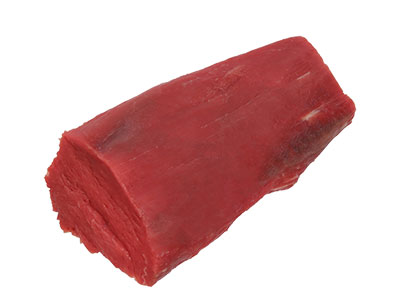Your guide to the best cuts of beef
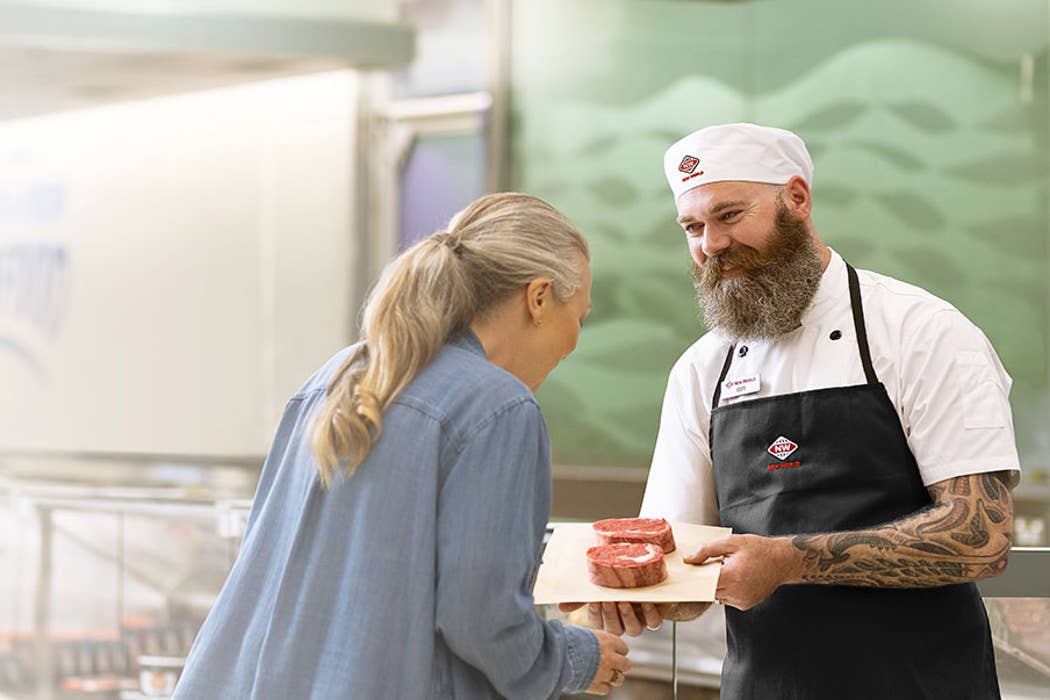
Red meat like beef is packed with minerals and vitamins like iron, helping to keep your body in fighting fit shape. Better still, some of the most tender, flavourful cuts of meat are beef and there’s a great range of different uses for this wonderful meat.
Below, we’ll explore the different cuts of beef, what they’re best for and some of our favourite beef recipes.
Beef mince
Beef mince, also called ground beef, can be made from any part of the cow. Cuts are passed through a meat grinder or mincer, breaking them down to be tender and malleable.
This means mince can be a great way to ensure the less desirable parts of the cow get used. Such parts are often tough, so being minced ensures the tough connective tissue is broken and the meat can be easily used, cooked and eaten.
However, higher-quality beef mince is often made using lean cuts, with a carefully controlled amount of fat added to guarantee a pleasant and healthy meat-to-fat ratio.
Because it can be easily shaped, beef mince is excellent for burger patties, meatballs or rissoles. It’s also great to include in sauces like bolognese, or as a filling for burritos.
When buying beef mince, check the label carefully: Most supermarkets offer different types of beef mince based on the amount of fat.
- Prime beef mince offers a reduced fat content at a moderate price. This is best for burgers, as the fat helps to keep the patties juicy.
- Premium beef mince offers the lowest fat content at a higher cost. This is best for stir-fries and pasta dishes where the fat isn’t necessary.
- If the label doesn’t say prime or premium, it most likely has more fat.
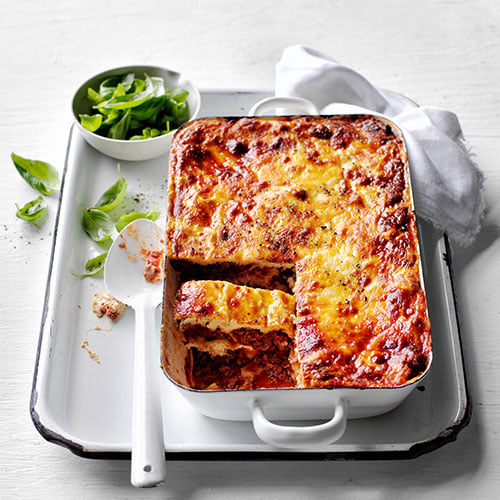 | Beef mince recipeEasy Beef LasagneFull of hearty vegetables, mince and three types of cheese. This is the ultimate comfort food. |
Beef frying steaks
Most people think of steak when it comes to beef. Steaks are taken from the most tender parts of the cow — furthest from the horns and the hooves.
These cuts are best seared in a hot pan. Thicker steaks may also need to spend some time in the oven to cook through, without overcooking the interior.
Different people like their steaks prepared in different ways:
- Blue steak is cooked from cold, over a very high temperature for a short time. It should be almost entirely raw on the inside, with light char on the outside.
- Rare steak is cooked more than blue, but should still be red on the inside. It should be browned all over but soft to the touch, with an internal temperature of 49° to 55° C.
- Medium-rare is the most commonly requested doneness. It should be tender and pink inside, with only a small amount of red. The internal temperature should be 55° to 57° C.
- Medium steak should have a thick band of pink meat through the middle, with an internal temperature of 60° to 66° C.
- Medium-well steak should only have a hint of pink through the centre. Its internal temperature should be 68° to 74° C.
- Well-done steak can easily be mistaken for overcooked steak. A good well-done steak should be cooked through, while still being moist, with an internal temperature of 77° C. For the home cook, many beef steak cuts are interchangeable. If a recipe calls for Scotch steak, it will most likely work with Sirloin or Rump as well. The key differences lie in tenderness, marbling and flavour.
| Rump steakRump steak is taken from the hindquarter of the cow, above the hip bone. It’s made up of four different muscles, and often has a strip of fat that runs around the curved edge and can easily be cut off. Otherwise, rump steak is fairly lean. For this reason, it can be overcooked easily but also offers a healthier alternative for those concerned about fat. Rump is firmer in texture than more premium cuts, but is affordable and delicious nonetheless. To cook, sear over a medium-high heat, turning only once. You might also cut rump steak up to use for a stir fry or quick curry. Beef rump steak recipesSear your rump steak and thinly slice it to add flavourful and simple protein to this delicious Thai-style salad. |
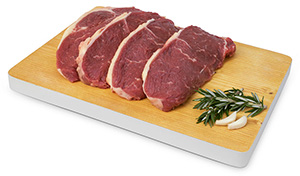 | Sirloin steakSirloin steak is a bit more tender than rump, but similarly lean. Cut from the back of the cow, towards the rump end of the spine, the sirloin muscles do less work and are naturally tender and juicy. This cut of steak is best suited for high-heat cooking methods such as pan searing or grilling on the barbecue. Take care to render down and fully cook the strip of fat along the edge of the sirloin, as this holds a lot of flavour but can be unpleasant if not cooked well. Sirloin may also be thinly sliced for a stir fry. Be sure to coat your sliced sirloin in flour before frying to prevent it from drying out when cooked. Beef sirloin steak recipesBeef StroganoffQuick cooking is key for this creamy beef stroganoff. Stir-fry your beef strips quickly and remove from the heat to prevent overcooking. |
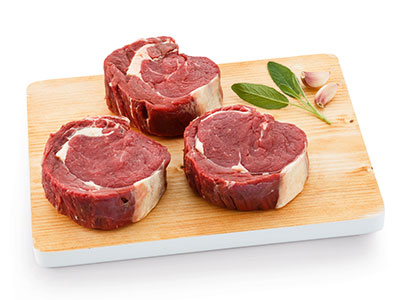 | Scotch steakScotch fillet steak is easily recognised by its beautiful marbling and the strip of fat that runs through one end of it. These steaks are prepared from a boneless beef rib set, taken from the back of the cow, after the shoulder (or chuck). The higher fat content of scotch makes it a popular choice for pan frying, as the fat keeps it moist and flavourful. Scotch steaks may be shaped into a neat circle with plastic wrap or string. This is purely an aesthetic decision, and you should remove any plastic prior to cooking. |
| Eye fillet steakThe eye fillet steak, or filet mignon, is taken from the strip of muscle either side of the spine that does the least amount of work. This means that on top of being extremely lean, tender and juicy, it’s also fairly scarce. Each cow only has a small amount of eye fillet within it, meaning eye fillet steaks are among the most expensive. This extremely beautiful cut is often best prepared simply. Salt, pepper, herbs and garlic are enough to make eye fillet steak sing. To cook, sear to medium rare. Beef eye fillet recipesChargrilled Eye Fillet with Asparagus SaladWhole grilled eye fillet pairs beautifully with this springtime asparagus salad. |
| Beef eye fillet tailThe eye fillet tail is the thinner end of the whole eye fillet. Because it’s thin, it’s best suited to being treated as a steak. Prepare this cut the same way you’d treat an eye fillet steak, then rest for 5 minutes before slicing against the grain to serve. |
 | T-bone steakWith a T-shaped bone in the middle creating great visual appeal, this steak features a juicy sirloin on the large side, and a strip of eye fillet on the smaller. Cook T-bone steaks on the BBQ, seasoned liberally with salt and pepper, and flipping only once to get great grill-marks. |
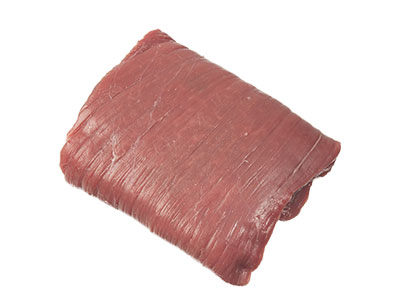 | Skirt steakSkirt steak is less commonly available in New Zealand, but it can be a wonderfully flavourful and unique cut. Remember — skirt steak is naturally more chewy than most frying steaks, because it’s taken from the cow’s abdominal muscles. Its toughness is best tenderised with an acidic marinade. To further tenderise the meat, skirt steak is best cooked quickly over a high temperature, to sear the outside but keep lots of moisture in. Slice thickly against the grain before serving. |
Slow cooker beef cuts
The more well-worked sections of the cow, such as the legs and shoulders, have more connective tissue making them tougher. These cuts are therefore cheaper and better suited to low, slow cooking methods.
Learn more: How to cook beef in a slow cooker.
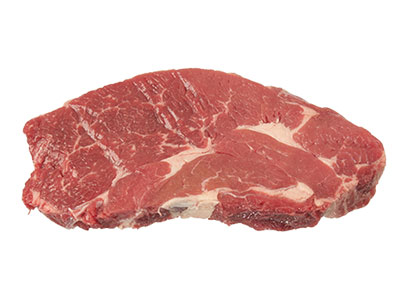 | Chuck steakChuck steak is taken from the first three ribs and the neck of the cow. The neck is, of course, used a lot by the cow so it’s full of connective tissue. Don’t turn your nose up at chuck, however — cooked low and slow, all that tissue melts away and you’re left with deeply flavourful, tender meat. Some visible fat can be ground on chuck steak, however this can be easily cut out or included to impart plenty more flavour. For any curry or stew, chuck is one of the best options. |
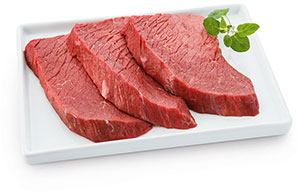 | Blade steakMuch like chuck, blade steak can be easily overlooked due to its toughness. It comes from the shoulder of the cow, after the chuck. However, blade steak is full of flavour and well-suited to being marinated. A great marinade will infuse this already flavourful cut with more deliciousness while also helping to tenderise it. Once marinated, sear off the blade steak before adding it to your casserole or stew. |
 | Cross cut blade steakFrom the same area as blade steak, cross cut blade can be used in much the same way. The key difference is that cross cut blade steak features a line of gristle down the centre of it. When cooked low and slow, this melts into gelatine, resulting in a more luscious, sticky casserole sauce or gravy. Cross cut blade steak recipesNell’s Braised Steak Casserole - With cross cut blade, this casserole makes a richly flavoured, sticky gravy. |
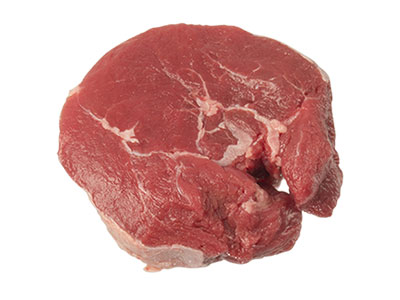 | Gravy beefGravy beef is a catch-all term for three parts of the cow that are commonly mixed together for casseroles. Specifically, gravy beef is taken from the neck, hind leg and front leg of the cow. This is a lean option with a lot of connective tissue, perfect for stews and casseroles. Gravy beef recipesBeef Casserole - This beef casserole uses gravy beef for affordable, rich flavour without extra fat or gelatine. |
Beef shin
Most commonly associated with osso buco, beef shin is a cut that may appear intimidating to the uninitiated. Shin is prepared from the bottom portion of the front or hind legs of the cow, and often has the cut bone still in it.
When braised down, the meat becomes delightfully tender and the marrow of the bone can gelatinise and become an incredibly rich, flavourful treat.
Beef cheek
Just as the name suggests, beef cheek or ox cheek comes from the face of the cow. It’s a well-used muscle, as the cow uses it every time it chews cud. Beef cheek is only really suitable for low, slow cooking. Cooked for 8-12 hours in red wine, stock and herbs, beef cheek can turn into a meal-in-the-mouth sumptuous feast.
Beef cheeks can come with a fair bit of sinew or silver skin in them. This should be cut out before cooking. To save you time, ask your New World butcher to prepare your beef cheeks for you.
Whole beef joints
Whole beef joints can often be cooked in a variety of ways. Because they’re so large, they can be broken down into smaller steaks, roasted whole, smoked, slow cooked or even corned.
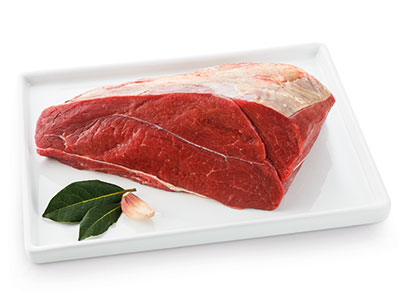 | Beef bolar roastA bolar roast is cut from the shoulder blade — much the same area as the blade steak. It’s a fairly tough cut, so long slow cooking goes a long way. Breaking down your own bolar roast can be a great economical way to buy meat for a casserole: simply dice it into one-inch cubes and use it in the same way you’d use blade steak. Otherwise, a bolar roast can be slow roasted whole for tender rare beef. Beef bolar roast recipesBolar Roast Rub - Try rubbing a bolar roast in this flavourful rub prior to roasting. |
 | Beef topside roastBeef topside is taken from the inner muscle of the cow’s thigh, near the silverside. However, because the inner muscle is slightly less worked, it’s more tender. Topside is a great roasting joint at a very reasonable price point. Like bolar, topside can also be diced for slow cooking. You might also find topside steaks. These can likewise be diced for slow cooking, or tenderised and pan fried. To tenderise, pound with a meat tenderiser or ask your New World butcher to do it for you. |
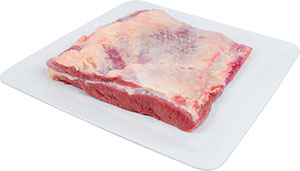 | Beef brisketBrisket is a super popular cut in the States, common among Southern barbecue cultures as well as Jewish cooking. This lean, working muscle is found in the lower chest or pectoral area of the cow. Brisket has a lot of connective tissue, so benefits from long slow cooking, whether that’s in a stew or casserole, braised for pulling or roasted on the barbecue or smoker. |
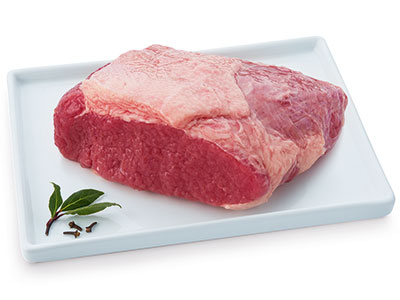 | Corned beef silversideSilverside is a cut of beef taken from the hindquarter, just above the leg. Its name comes from the silver wall of connective tissue that sits on the side of the cut, however this should be removed before cooking. You’ll most often find silverside sold in NZ as corned beef. Corned beef is cured with salt, sugar and spices, imparting loads of flavour and ensuring the meat remains succulent and tender once cooked. |
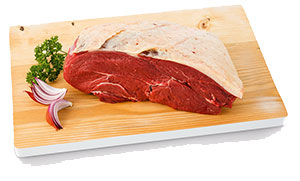 | Beef rump pieceA beef rump piece is the whole joint that rump steaks are cut from. One of the simplest things you can do with a rump piece is to cut your own steaks. Alternatively, it makes a wonderful roast or slow cooker meat. To roast, sear the rump piece all over in a frying pan and place in a 200° C oven, fat side up for about 20 minutes. Rest for 15 minutes before carving against the grain. To slow cook, dice the whole piece into 1-inch cubes and follow your slow cooker meal recipe. |
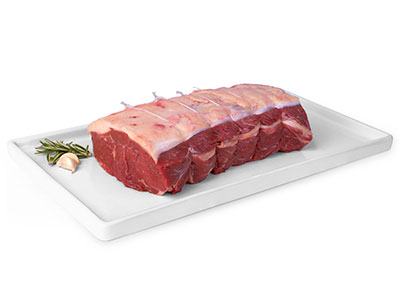 | Beef sirloin pieceA sirloin piece can be cut into steaks or roasted whole. To roast it whole, use a sharp knife to cut 8-10 deep slashes just through the fat cap. This creates more surface area, so the meat cooks evenly and you get a delicious caramelised crust. Sear all over in a frying pan, then roast in a 200° C oven for 15-20 minutes per 500g for medium-rare. Turn halfway through roasting, and rest for 15 minutes before carving. |
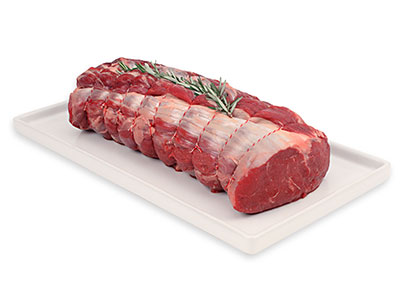 |
Beef scotch fillet piece
A whole scotch fillet is a real centrepiece at the dinner table. The beautiful marbling runs the whole way through the fillet, providing lots of flavour and juiciness. Take the joint out of the fridge for half an hour before cooking, then roast the scotch fillet piece at 200° C for 15-20 minutes per 500g for medium-rare. Rest for 15 minutes before slicing. |
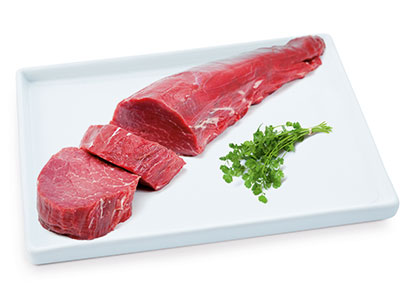 | Whole beef eye filletEye fillet can be cut into steaks, however it’s also a wonderful piece to roast whole and cut at the table. For best results, ensure any silverskin is trimmed from the fillet, then rub in oil, salt and pepper and allow it to come to room temperature. Sear the fillet in a frying pan or on the barbecue over a high heat, then place in a 190° C oven for about 10 minutes per 500g, or an internal temperature of 55° C for medium rare. Beef eye fillet piece recipesChargrilled Eye Fillet with Asparagus Salad - Try this herb-crusted eye fillet recipe for beautiful wall-to-wall medium-rare beef dripping in flavour. |
Beef ribs
Ribs are a bone-in cut that are popular in barbecue. You’re probably used to seeing them smoked or slow-roasted and slathered in sticky sweet barbecue sauce.

Standing rib roast
A standing rib roast is essentially a scotch fillet with the bone left in. It’s more akin to a scotch fillet roast than what you’d ordinarily think of when someone says “ribs”. It can be cooked in the same way as a scotch fillet, or slower at 160° C.
To slow cook a standing rib roast, heat the oven to 200°C. Brown the meat all over in a frying pan, then roast in an oven safe dish in the oven for 15 minutes. After 15 minutes, reduce the heat to 160°C and cook for a further 20 minutes per 500g for medium beef.
Beef spare ribs
Spare ribs and short ribs are ultimately the same part of the cow. While the standing rib roast comes from the top of the cow, closer to the spine, the spare ribs are taken from the forequarter after the brisket is removed.
The key difference between spare ribs and short ribs is how they’re cut. Spare ribs, also called plate ribs, are typically intact as one large piece, while short ribs are usually separated into individual ribs ahead of time.
Beef spare ribs are best smoked or cooked whole on the barbecue. To slow-cook your ribs, preheat the barbie to 120° C and cook over indirect heat for 1-1.5 hours, turning every 15 minutes. Once the thickest part of the ribs reaches 73° C, they’re ready to be glazed in your favourite BBQ sauce.
Beef short rib
Beef short ribs get their name because they are typically cut short — about 3” long. This might not always be the case, as it’s increasingly common to see full length individually cut ribs sold as short ribs.
Short ribs are best slow cooked in liquid, such as stock with aromatics. This results in succulent fall-off-the-bone meat.
Hungry for more?
Discover more tips and tricks from your New World butchery, or shop from our great range of fresh NZ beef cuts or prepackaged beef.


